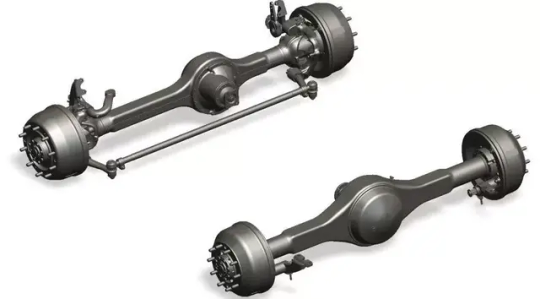#AutomaticAxleMarket
Explore tagged Tumblr posts
Text
Automatic Axle Market Drivers Shaping Global Automotive Manufacturing and Mobility Dynamics Rapidly
The automatic axle market is undergoing a significant transformation as automotive technologies evolve and consumer preferences shift. Driven by technological advancements and the demand for efficient, durable, and high-performing vehicle components, automatic axles have become essential across a wide range of vehicle segments including passenger cars, commercial vehicles, and off-highway machines. Several key drivers are propelling the market's upward trajectory, influencing OEM decisions, industry investments, and regional market expansions.

Rise in Electric and Hybrid Vehicle Adoption
One of the most influential drivers of the automatic axle market is the rapid growth in electric and hybrid vehicle production. Electric vehicles (EVs) require specialized drivetrain configurations that often include integrated or independent axles with automatic functions for torque distribution and efficiency. As governments worldwide push for carbon-neutral transportation and introduce incentives for EV purchases, automotive manufacturers are ramping up production. Automatic axles are increasingly integrated into EV designs to enhance performance and power management.
This shift is not only increasing demand for high-performance axle systems but also prompting technological innovations such as lightweight materials and electric axle integration (e-axles), which combine motor, power electronics, and transmission into a single compact unit.
Demand for Enhanced Fuel Efficiency and Powertrain Optimization
Rising fuel prices and stricter emissions regulations are pushing automakers to adopt fuel-efficient drivetrain solutions. Automatic axles contribute to optimized power distribution, better torque management, and smoother gear shifts, which in turn improve vehicle fuel efficiency and driving experience. By reducing the need for manual intervention in gear transitions, automatic axle systems help minimize power loss and improve engine output regulation.
The growing use of these axles in commercial fleets and logistics vehicles reflects a focus on total cost of ownership. Businesses are increasingly investing in vehicles that offer better mileage, reduced maintenance, and longer lifecycle value—all of which are benefits associated with automatic axle systems.
Expansion of Commercial and Heavy-Duty Vehicle Market
The global boom in e-commerce and infrastructure development has created a higher demand for trucks, buses, and off-road construction vehicles, especially in emerging economies. These vehicles require robust and reliable axle systems that can endure heavy loads and varying terrain conditions. Automatic axles provide a performance edge by offering superior load distribution, reduced driver fatigue, and smoother operation in challenging environments.
Moreover, the integration of automatic systems in long-haul trucks is becoming a standard, as they allow for better route efficiency, lower emissions, and less strain on the vehicle’s powertrain.
Technological Innovations and Smart Mobility Integration
The ongoing evolution of smart and connected vehicles has made automation in vehicle components more important than ever. Automatic axles are being equipped with sensors and actuators that interact with onboard computers to dynamically respond to driving conditions. Features such as adaptive load balancing, automated torque vectoring, and integration with vehicle stability controls are increasingly common.
This technological leap is also closely tied to the rise in autonomous and semi-autonomous driving systems. Vehicles with advanced driver assistance systems (ADAS) require drive components like automatic axles that can intelligently respond without manual driver input, making them vital for next-gen vehicle platforms.
Urbanization and Demand for Comfortable Driving Experience
As urban areas become more congested and daily commutes grow longer, drivers are seeking vehicles that offer comfort and ease of operation. Automatic axle systems contribute significantly by reducing the effort required for gear changes, allowing for smoother acceleration and less vibration. This is particularly appealing in urban SUVs and crossovers, which have seen a surge in popularity in recent years.
Additionally, the ability to integrate seamlessly with automatic transmission systems makes automatic axles ideal for modern vehicles where driver convenience is a major selling point.
Regulatory Push for Safety and Emissions Compliance
Governments and regulatory bodies are increasingly focused on enforcing vehicle safety standards and emissions controls. Automatic axles help manufacturers meet these requirements by ensuring smoother gear transitions, better traction control, and improved drivetrain stability. Their role in supporting electric powertrains also aligns with environmental goals and zero-emission targets set by various countries.
As OEMs work to comply with these regulations while maintaining vehicle performance, the inclusion of automatic axle systems becomes not just a preference but a necessity.
Conclusion
The automatic axle market is being driven by a complex mix of environmental, economic, and technological factors. The rise of electric vehicles, the need for greater fuel efficiency, advancements in automotive technology, and regulatory mandates are converging to accelerate market growth. Manufacturers are responding with innovative designs and smarter axle systems that meet the demands of both today’s consumers and tomorrow’s mobility landscape.
As the automotive industry continues to evolve toward electrification and automation, automatic axles will remain a foundational component, ensuring optimal performance, comfort, and efficiency across all vehicle types.
0 notes